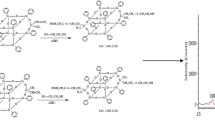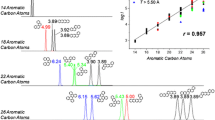Abstract
HPLC was used as the quantitative analysis technique in determining the molar ratio of cis and trans isomers in the double-decker shaped silsesquioxanes (DDSQ). Different experiments were performed to analyze the effects in the retention times of the polarity of moieties bonded to the DDSQ, as well as other possible adsorption driving forces. As expected, the use of adsorption HPLC was successful in separating cis and trans DDSQ isomers with the resolution of elution better than 1.5. Interestingly, the molecular size of moiety attached to the DDSQ resulted in significant reduction of the retention time suggesting the sterics constraint plays a critical role in the separation of these cage-like structures along with the strength of hydrogen bonding. In partition HPLC using Si bonded with CN groups as a normal phase resulted in a partial separation for one of the selected systems, which indicates the extent of polarity plays a secondary role in the separation mechanism.
Similar content being viewed by others
References
Wu S, Hayakawa T, Kikuchi R, Grunzinger SJ, Kakimoto M-A, Oikawa H (2007) Synthesis and characterization of Semiaromatic polyimides containing POSS in Main chain derived from double-Decker-shaped Silsesquioxane. Macromolecules 40:5698–5705. https://doi.org/10.1021/ma070547z
Żak P, Majchrzak M, Wilkowski G, Dudziec B, Dutkiewicz M, Marciniec B (2016) Synthesis and characterization of functionalized molecular and macromolecular double-decker silsesquioxane systems. RSC Adv 6:10054–10063. https://doi.org/10.1039/C5RA20848C
Liu N, Wei K, Wang L, Zheng S (2016) Organic–inorganic polyimides with double decker silsesquioxane in the main chains. Polym Chem 7:1158–1167. https://doi.org/10.1039/C5PY01827G
Liu N, Li L, Wang L, Zheng S (2017) Organic-inorganic polybenzoxazine copolymers with double decker silsesquioxanes in the main chains: synthesis and thermally activated ring-opening polymerization behavior. Polymer 109:254–265. https://doi.org/10.1016/j.polymer.2016.12.049
Schoen BW (2013) Aminophenyl double decker silsesquioxanes: Spectroscopic elucidation, physical and thermal characterization, and their applications
Wei K, Wang L, Zheng S (2013) Organic–inorganic polyurethanes with 3,13-dihydroxypropyloctaphenyl double-decker silsesquioxane chain extender. Polym Chem 4:1491–1501. https://doi.org/10.1039/C2PY20930F
Hoque MA, Kawakami Y (2016) Synthesis of Polysilsesquioxanes with double-Decker Silsesquioxane repeating units. J Sci Res 8:217–227. https://doi.org/10.3329/jsr.v8i2.26791
Hoque MA, Kakihana Y, Shinke S, Kawakami Y (2009) Polysiloxanes with periodically distributed isomeric double-Decker Silsesquioxane in the Main chain. Macromolecules 42:3309–3315. https://doi.org/10.1021/ma900124x
Schoen BW, Lira CT, Lee A (2014) Separation and solubility of Cis and trans isomers in nanostructured double-Decker Silsequioxanes. J Chem Eng Data 59:1483–1493. https://doi.org/10.1021/je4010245
Schoen BW, Holmes D, Lee A (2013) Identification and quantification of cis and trans isomers in aminophenyl double-decker silsesquioxanes using 1H--29Si gHMBC NMR. Magn Reson Chem 51:490–496
Walczak M, Januszewski R, Majchrzak M, Kubicki M, Dudziec B, Marciniec B (2017) Unusual cis and trans architecture of dihydrofunctional double-decker shaped silsesquioxane and synthesis of its ethyl bridged π-conjugated arene derivatives. New J Chem 41:3290–3296. https://doi.org/10.1039/C7NJ00255F
Ervithayasuporn V, Sodkhomkhum R, Teerawatananond T, Phurat C, Phinyocheep P, Somsook E, Osotchan T (2013) Unprecedented formation of cis-and trans-Di [(3-chloropropyl) isopropoxysilyl]-bridged double-Decker Octaphenylsilsesquioxanes. Eur J Inorg Chem 2013:3292–3296
Seurer B, Vij V, Haddad T, Mabry JM, Lee A (2010) Thermal transitions and reaction kinetics of Polyhederal Silsesquioxane containing Phenylethynylphthalimides. Macromolecules 43:9337–9347. https://doi.org/10.1021/ma101640q
Lee A (2018) Separation and Phase Behavior of Double-Decker Silsesquioxane Isomers. In: Proceedings of the 3rd World Congress on Recent Advances in Nanotechnology. Avestia Publishing
Vogelsang DF, Dannatt JE, Maleczka RE, Lee A (2018) Separation of asymmetrically capped double-decker silsesquioxanes mixtures. Polyhedron 155:189–193. https://doi.org/10.1016/j.poly.2018.08.016
Snyder LR, Kirkland JJ, Dolan JW (2010) Introduction to modern liquid chromatography3rd edn. Wiley, Hoboken, N.J
Ghasemi J, Niazi A (2005) Spectrophotometric simultaneous determination of nitroaniline isomers by orthogonal signal correction-partial least squares. Talanta 65:1168–1173. https://doi.org/10.1016/j.talanta.2004.08.052
Howell JA, Sutton RE (1998) Ultraviolet and absorption light spectrometry. Anal Chem 70:107–118. https://doi.org/10.1021/a19800040
Scott RPW (1976) The role of molecular interactions in chromatography. J Chromatogr A 122:35–53. https://doi.org/10.1016/S0021-9673(00)82235-9
Acknowledgments
We thank the Office of Naval Research (N00014-16-2109) for funding and Program Manager Mr. William Nickerson for the support. We also acknowledge Dr. Beth Schoen and Ms. Gayanthi Attanayake for their collaboration synthesizing and providing the DDSQ-(Ph)8(aniline)(R2) materials.
Author information
Authors and Affiliations
Corresponding authors
Electronic supplementary material
ESM 1
(DOCX 3.77 kb)
Rights and permissions
About this article
Cite this article
Vogelsang, D.F., Maleczka, R.E. & Lee, A. HPLC Characterization of cis and trans Mixtures of Double-Decker Shaped Silsesquioxanes. Silicon 11, 5–13 (2019). https://doi.org/10.1007/s12633-018-0045-4
Received:
Accepted:
Published:
Issue Date:
DOI: https://doi.org/10.1007/s12633-018-0045-4




